Output of Finland's national economy grew in April to June
In the April to June period, the seasonally adjusted volume of Finland’s gross domestic product grew by 0.5 per cent from the previous quarter. GDP adjusted for working days grew by 1.2 per cent compared to the second quarter of 2018. Examined at current prices, gross domestic product adjusted for working days was 3.3 per cent higher than one year ago.
Figure 1 .Volume change of GDP from the previous quarter, seasonally adjusted, per cent
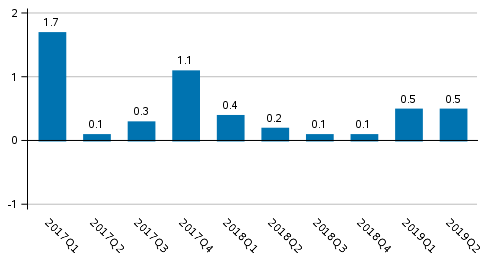
According to preliminary data compiled by Eurostat, GDP in the EU-28 area grew by 0.2 per cent in the second quarter from the previous quarter and by 1.3 per cent from one year back.
Output
The volume of total value added generated by all industries increased by 0.5 per cent from the previous quarter and by 1.6 per cent from twelve months back.
Figure 2. Changes in the volume of value added generated by industries in the second quarter of 2019 compared to one year ago, working-day adjusted, per cent
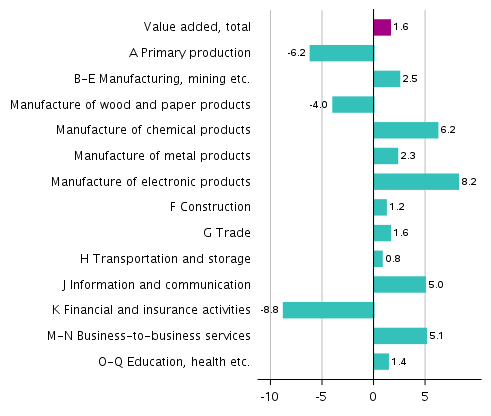
Figure 3. Changes in the volume of value added generated by industries in the second quarter of 2019 compared to the previous quarter, seasonally adjusted, per cent
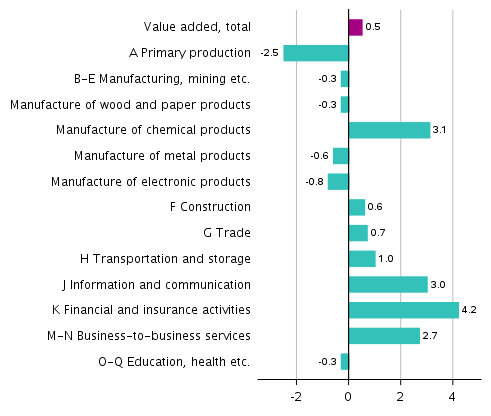
In primary production, that is, agriculture, forestry and fishing, the volume of value added decreased in April to June by around six per cent year-on-year and by around two and a half per cent from the previous quarter. The volume of value added in agriculture declined by slightly under 10 per cent and in forestry by around five per cent from last year.
Output in manufacturing industries (incl. mining and quarrying, energy, water supply and waste management) grew by around two and a half per cent in April to June from one year ago. Output in the manufacture of wood and paper products contracted by four per cent from its level one year ago. In the manufacture of chemicals and chemical products, output increased by six per cent and in the manufacture of metal products and machinery (excl. electrical and electronics industry) by two per cent from twelve months earlier. The electrical and electronics industry grew in the second quarter by eight per cent from twelve months back. Output in manufacturing was in total slightly under three per cent higher than one year before.
The construction industry grew by good one per cent in April to June from the previous year. The volume of building construction grew by around one per cent and that of civil engineering by slightly under one per cent compared to the corresponding quarter of the year before.
The volume of service industries grew by close on one per cent from the previous quarter’s level, up by slightly under two per cent from the previous year. Compared to the second quarter of 2018, the value added of general government services grew by one per cent and that of private services by two per cent.
The volume of trade was around one and a half per cent higher in April to June than one year earlier. The volume of value added in trade for January to March became revised to approximately the same level as in the first quarter of 2018 (was on a level approximately two per cent lower). Motor vehicle trade contracted year-on-year, but retail trade and wholesale trade grew. The most favourable development was seen in information and communication and business activities.
Imports, exports, consumption and investments
Total demand increased in April to June by 2.0 per cent from the second quarter in 2018. Demand in the national economy was mainly boosted by growth in exports, public consumption expenditure and investments.
Figure 4. Changes in the volume of main supply and demand items in the second quarter of 2019 compared to one year ago, working-day adjusted, per cen
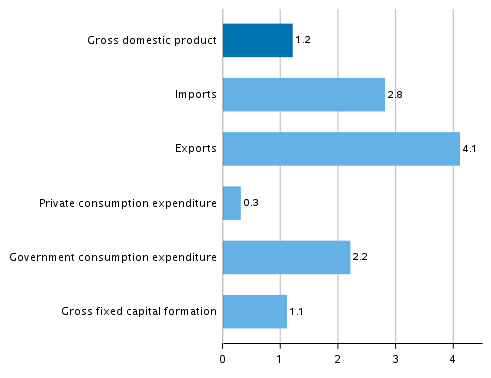
Figure 5. Changes in the volume of main supply and demand items in the second quarter of 2019 compared to the previous quarter, seasonally adjusted, per cent
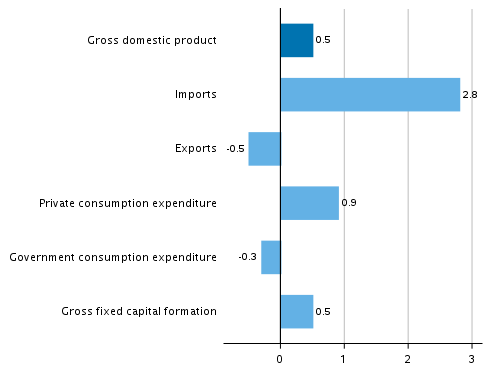
In April to June, the volume of exports decreased by half a per cent from the previous quarter, but increased by four per cent year-on-year. Compared to the second quarter of 2018, exports of goods went up by around half a per cent and exports of services by around 13 per cent.
The volume of imports grew by three per cent from twelve months back and also by three per cent from the previous quarter. Imports of goods grew by one per cent and imports of services by seven per cent year-on-year.
In the second quarter, private consumption remained more or less on level with the previous year. Public consumption expenditure grew by two per cent compared to the second quarter of 2018.
Gross fixed capital formation, or investments, increased slightly from the previous quarter. Private investments remained on level with the previous year while public investments increased by around six per cent from one year back. The volume of investments in machinery, equipment and transport equipment increased by two and a half per cent from the second quarter of 2018. Investments in residential buildings remained at last year’s level. Investments in non-residential buildings grew by four per cent from one year ago. Investments in civil engineering contracted by around half a per cent year-on-year. Investments in intellectual property products including software, research and development, declined by two per cent from twelve months back.
Employment, wages and salaries and national income
In April to June, the number of employed persons increased by 0.9 per cent year-on-year. The number of hours worked in the national economy grew by 0.1 per cent from one year back.
According to Statistics Finland’s Labour Force Survey, the rate of unemployment for the April to June period was 7.7 per cent, while in last year’s corresponding period it was 8.2 per cent.
In the April to June period, the nominal wages and salaries bill of the national economy grew by 1.1 per cent from the previous quarter and by 3.4 per cent year-on-year. Social contributions paid by employers decreased by 2.0 per cent from one year back.
The operating surplus (net), which in business bookkeeping corresponds roughly with operating profit, grew in the second quarter by 6.2 per cent from twelve months back. Gross national income calculated at current prices was 3.5 per cent higher than one year previously.
The available data
These preliminary quarterly data are based on the source information on economic development that had become available by 26 August 2019. The annual level data for 1990 to 2018 correspond with the National Accounts data released on 20 June 2019, except for those on the rest of the world sector (imports, exports, primary income from/to the rest of the world), which may have become revised. The annual data for 1990 to 2018 may become revised in connection with the time series revision of annual national accounts in September, which is published on 20 September 2019.
Data on the third quarter of 2019 will be released on 29 November 2019, when the data for previous quarters will also be revised. A flash estimate on GDP development for July to September will be released in connection with the Trend Indicator of Output on 14 November 2019.
Due to the benchmarking and seasonal adjustment methods, quarterly data may become slightly revised in connection with each release. However, the largest revisions take place during the two to three years following the release of a quarter, because final annual accounts data are published at a lag of around two years from the end of the statistical reference year. Seasonally adjusted and trend time series always become revised against new observations irrespective of whether the original time series becomes revised or not.
The quality description is available on Statistics Finland's website: http://www.tilastokeskus.fi/til/ntp/laa.html .
Methodological description of Quarterly National Accounts.Source: National Accounts 2019, 2:nd quarter. Statistics Finland
Inquiries: Samu Hakala 029 551 3756, Antti Kosunen 029 551 3613, kansantalous.suhdanteet@stat.fi
Director in charge: Ville Vertanen
Updated 30.8.2019
Official Statistics of Finland (OSF):
Quarterly national accounts [e-publication].
ISSN=1797-9765. 2nd quarter 2019,
Output of Finland's national economy grew in April to June
. Helsinki: Statistics Finland [referred: 8.1.2026].
Access method: http://stat.fi/til/ntp/2019/02/ntp_2019_02_2019-08-30_kat_001_en.html

